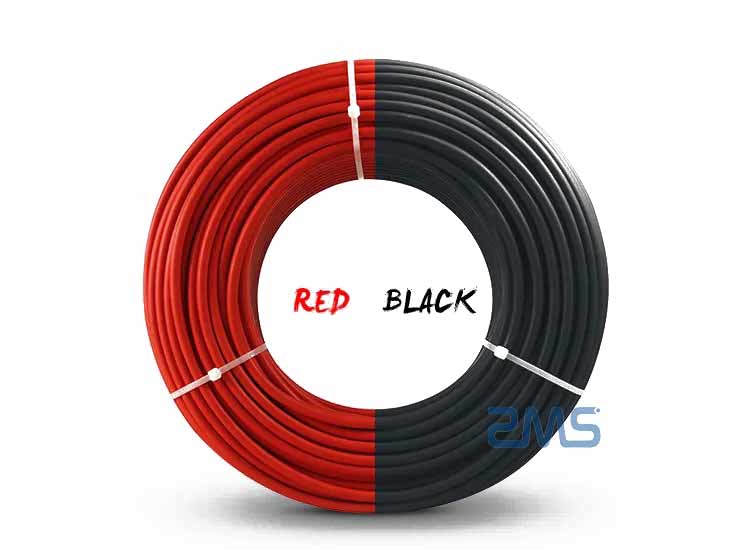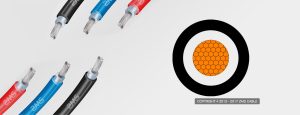

Il-materjal tal-konduttur tal-kejbil fotovoltajku huwa ġeneralment konduttur tar-ram jew konduttur tar-ram fil-landa.
Il-bini tal-impjanti tal-enerġija fotovoltajka kosteffikaċi u profittabbli jirrappreżenta l-aktar għan u kompetenza ewlenija tal-manifatturi kollha tal-kejbil solari.
Il-profittabilità tiddependi mhux biss fuq l-effiċjenza jew il-prestazzjoni għolja tal-moduli solari nfushom, iżda wkoll fuq serje ta 'komponenti li fuq il-wiċċ ma jidhrux relatati direttament mal-moduli.
Pereżempju, Jekk impjant PV jonqos milli juża l-kejbils it-tajba, Il-ħajja tas-sistema kollha se tkun affettwata.
Allura, X'inhu kejbil PV?
Kejbil PV huwa kejbil cross-link tar-raġġ elettroni 120 °C. Din il-klassifikazzjoni tikkorrispondi għal 18 snin ta 'servizz f'temperatura kontinwa ta' 90 °C. U ddum aktar meta t-temperatura tkun taħt 90 °C.


Il- Karatteristiċi tal-kejbils solari huma determinati mill-insulazzjoni speċjali tal-kejbil u materjal tal-għant tagħhom, imsejjaħ PE marbut ma 'Cross. Li huwa irradjat minn pedala tal-gass ta 'irradjazzjoni biex tbiddel l-istruttura molekulari tal-materjal tal-kejbil u b'hekk tipprovdi l-proprjetajiet individwali tagħha. Waqt l-installazzjoni u l-manutenzjoni, Il-kejbil jista 'jgħaddas fuq it-truf li jaqtgħu tal-istruttura tas-saqaf. Filwaqt li l-kejbil huwa soġġett għal pressjoni, liwi, tensjoni, tagħbijiet ta 'tensjoni trasversali, u impatti qawwija.
Jekk il-għant tal-kejbil mhuwiex b'saħħtu biżżejjed, L-insulazzjoni tal-kejbil tkun imħassra serjament. B'hekk taffettwa l-ħajja tal-kejbil kollu, jew li jwassal għal ċirkwiti qosra, Nirien u korrimenti, u problemi perikolużi oħra.
Minbarra t-tagħmir ewlieni fil-proċess tal-kostruzzjoni ta 'impjanti tal-enerġija fotovoltajka solari. Bħal moduli fotovoltajċi, inverters, u t-transformers tal-pass. Minbarra l-appoġġ tal-konnessjoni ta ' kejbil solari Materjali għall-profittabilità ġenerali ta 'impjanti ta' enerġija fotovoltajka. Is-sigurtà tal-operazzjoni, kemm jekk effiċjenti, għandu wkoll rwol vitali.
Is-segwenti hija introduzzjoni dettaljata għall-kejbils u l-materjali komuni użati fl-impjanti tal-enerġija fotovoltajċi u l-użu tagħhom tal-ambjent.
Kejbils skont is-sistema tal-impjant tal-enerġija fotovoltajka jistgħu jinqasmu f'kejbils DC u kejbils AC, Skond l-użu u l-użu ta 'ambjenti differenti huma kklassifikati kif ġej:
1 Kejbils tas-serje bejn komponenti u moduli.
2 Kejbils paralleli bejn il-kordi u bejn il-kordi u d-DC kaxxa tad-distribuzzjoni.
3 Kejbil bejn il-kaxxa tad-distribuzzjoni DC u l-inverter.
Il-kejbils ta 'hawn fuq huma kejbils DC, li huma aktar spiss imqiegħda fil-beraħ u jeħtieġ li jkunu prova tal-umdità, Sunproof, Proof kiesaħ, prova tas-sħana, u l-UV-proof. U f'xi ambjenti speċjali, Jeħtieġu wkoll li jkunu protetti minn kimiċi bħal aċidi u alkali.
1 Inverter għall-kejbil tal-konnessjoni tat-transformer.
2 Il-kejbil tal-konnessjoni mit-transformer tal-pass għall-unità tad-distribuzzjoni.
3 Il-kejbil tal-konnessjoni mill-unità tad-distribuzzjoni sal-grilja jew il-klijent.
Din il-parti tal-kejbil hija kejbil tat-tagħbija AC, L-ambjent ta 'ġewwa jistabbilixxi aktar, jistgħu jintgħażlu wara r-rekwiżiti ġenerali tal-għażla tal-kejbil tal-enerġija.
Stazzjonijiet tal-qawwa fotovoltajka tal-qawwa solari f'ħafna kejbils DC li għandhom jiġu mqiegħda barra, f'kundizzjonijiet ambjentali ħorox. Il-materjal tal-kejbil għandu jkun ibbażat fuq ir-reżistenza għal dawl ultravjola, ożonu, Bidliet severi fit-temperatura, u erożjoni kimika.
Kejbil materjali komuni f'dan l-ambjent għal żmien twil iwassal biex il-għant tal-kejbil ikun fraġli, u anke jiddekomponi l - saff ta 'insulazzjoni tal-kejbil.
Dawn il-kundizzjonijiet jistgħu jagħmlu ħsara direttament lis-sistema tal-kejbil u jżidu wkoll ir-riskju ta 'ċirkwit qasir tal-kejbil.
Fit-tul medju sa twil, Il-possibbiltà ta 'nar jew korriment għall-persunal hija wkoll ogħla, Jaffettwa ħafna l-ħajja tas-servizz tas-sistema. Għalhekk, Huwa essenzjali li jintużaw kejbils u komponenti speċifiċi għall-PV f'impjanti tal-enerġija PV.
Kejbils u komponenti speċifiċi għall-PV mhumiex biss reżistenti bl-aħjar mod għat-temp, UV, u attakk tal-ożonu, iżda jista 'wkoll jiflaħ firxa akbar ta' varjazzjonijiet fit-temperatura.
Il - kejbils użati fil - Trasmissjoni DC ta 'vultaġġ baxx Parti minn sistema ta 'enerġija PV solari għandhom rekwiżiti differenti għall-konnessjoni ta' komponenti differenti. Minħabba l-ambjent tal-użu u r-rekwiżiti tekniċi.
Il-fatturi ġenerali li għandhom jiġu kkunsidrati huma l-prestazzjoni tal-insulazzjoni tal-kejbil, Reżistenza tas-sħana u tal-fjammi, Prestazzjoni tax-xjuħija, u speċifikazzjonijiet tad-dijametru tal-wajer.
Rekwiżiti speċifiċi huma kif ġej:
Ġeneralment uża l-kejbil tal-konnessjoni mwaħħal mal-kaxxa tal-ġonta tal-modulu biex tikkonnettja direttament, It-tul mhuwiex biżżejjed biex tuża kejbil ta 'estensjoni speċjali.
Jiddependi fuq id-daqs tal-qawwa tal-komponent, Dan it-tip ta 'kejbil ta' konnessjoni għandu żona ta 'sezzjoni trasversali ta' 2.5 m㎡, 4.0 m㎡, 6.0 m㎡, u tliet speċifikazzjonijiet oħra.
Dan it-tip ta 'kejbil ta' konnessjoni juża saff doppju ta 'għant ta' insulazzjoni. Li għandu reżistenza superjuri għad-dawl ultravjola, ilma, ożonu, aċidu, u erożjoni tal-melħ, Kapaċità superjuri tat-temp kollu, u l-ilbies tar-reżistenza.
Huwa meħtieġ li tuża kejbil flessibbli b'ħafna strand ul-ittestjat u tikkonnettja kemm jista 'jkun viċin.
L-għażla ta 'kejbils qosra u ħoxnin tista' tnaqqas it-telf tas-sistema, ittejjeb l-effiċjenza u ttejjeb l-affidabbiltà.
Huwa meħtieġ ukoll li tuża ul-ittestjat b'ħafna stranded kejbil flessibbli, u ż-żona ta 'sezzjoni trasversali hija bbażata fuq il-kurrent massimu tal-ħruġ tal-firxa.
Iż-żona ta 'sezzjoni trasversali tal-kejbil DC ta' kull parti hija ddeterminata skond il-prinċipji li ġejjin:
Għall-kejbil tal-konnessjoni bejn moduli solari u komponenti, il-kejbil tal-konnessjoni bejn il-batterija u l-batterija. U l-kejbil tal-konnessjoni għat-tagħbija AC, Il-klassifikazzjoni tal-kurrent tal-kejbil hija ġeneralment magħżula bħala 1.25 drabi l-kurrent operattiv kontinwu massimu f'kull kejbil.
Il-kejbils tal-konnessjoni bejn matriċi taċ-ċelloli solari u matriċi, il-kejbils tal-konnessjoni bejn banek tal-batteriji u inverters. Ġeneralment, Il-kurrent magħżul b'valur tal-kejbil huwa 1.5 drabi l-kurrent operattiv kontinwu massimu f'kull kejbil.
Hawn fuq hija introduzzjoni ġenerali għall-kejbils solari, kif ukoll xi kunsiderazzjonijiet meta tixtri kejbils. Il-manifattur tal-kejbil ZMS iwiegħed li jkollu kejbil solaris manifatturat skont l-istandards internazzjonali, kif ukoll varjetà ta 'komponenti u servizzi kompluti. Jekk għandek xi mistoqsijiet dwar ix-xiri ta 'kejbils solari, Jekk jogħġbok tħossok liberu li tikkonsulta magħna. U se jkollna rappreżentant professjonali tal-bejgħ tal-kejbil biex jgħinek.
When people hear the term mineral insulated cable, many immediately think of harsh environments like…
As telecommunication networks and power transmission systems grow rapidly, the demand for reliable and cost-effective…
In large-scale oil and gas projects, industrial cables are not just accessories—they are the "nervous…
In the world of electrical connections, cable lugs—also known as cable ears or cable terminals—huma…
When choosing the right rubber cable for an electrical engineering project, it is critical to…
Għeżież Imsieħba u Klijenti: 29 ta 'Jannar, 2025 Is-Sena l-Ġdida Lunar Ċiniża hija – Spring…